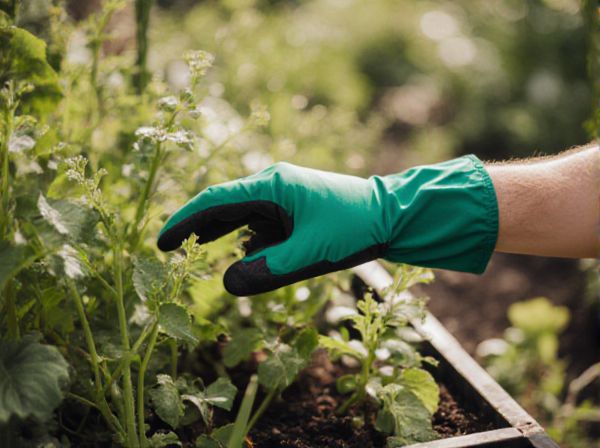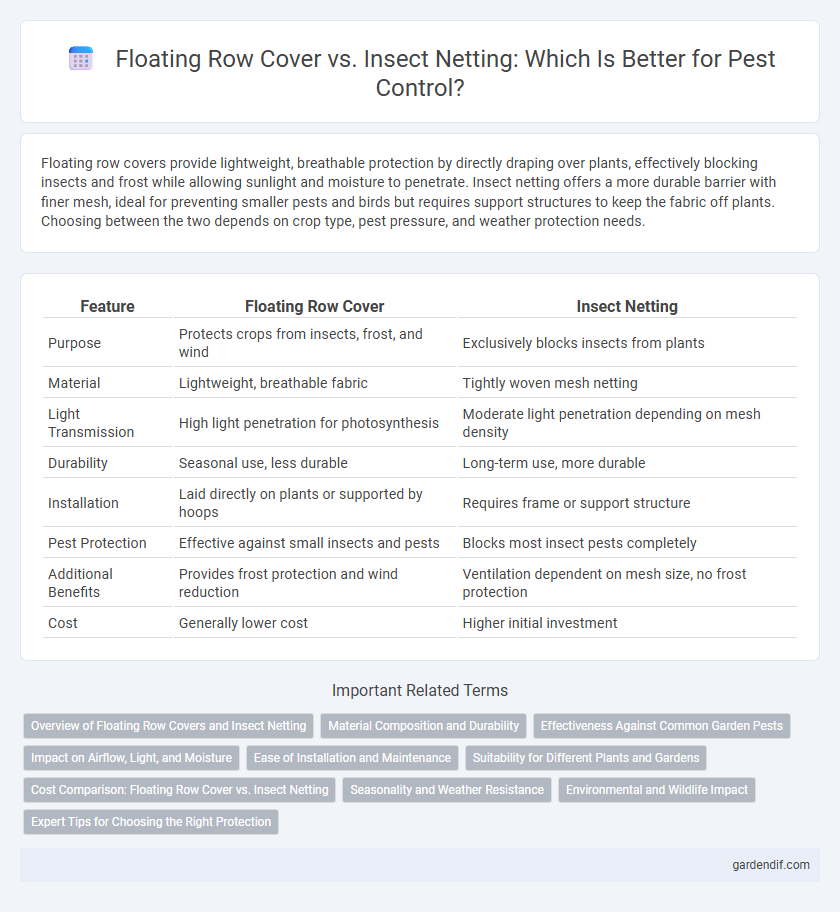
Floating row cover vs Insect netting Illustration
Floating row covers provide lightweight, breathable protection by directly draping over plants, effectively blocking insects and frost while allowing sunlight and moisture to penetrate. Insect netting offers a more durable barrier with finer mesh, ideal for preventing smaller pests and birds but requires support structures to keep the fabric off plants. Choosing between the two depends on crop type, pest pressure, and weather protection needs.
Table of Comparison
| Feature | Floating Row Cover | Insect Netting |
|---|---|---|
| Purpose | Protects crops from insects, frost, and wind | Exclusively blocks insects from plants |
| Material | Lightweight, breathable fabric | Tightly woven mesh netting |
| Light Transmission | High light penetration for photosynthesis | Moderate light penetration depending on mesh density |
| Durability | Seasonal use, less durable | Long-term use, more durable |
| Installation | Laid directly on plants or supported by hoops | Requires frame or support structure |
| Pest Protection | Effective against small insects and pests | Blocks most insect pests completely |
| Additional Benefits | Provides frost protection and wind reduction | Ventilation dependent on mesh size, no frost protection |
| Cost | Generally lower cost | Higher initial investment |
Overview of Floating Row Covers and Insect Netting
Floating row covers are lightweight, breathable fabrics that protect plants from pests while allowing sunlight, air, and moisture to reach crops, making them ideal for vegetable gardens and small-scale farming. Insect netting is a durable mesh material designed to block insect entry completely, providing a physical barrier against a wider range of pests without restricting airflow or light. Both methods offer effective pest control but vary in material composition, application, and level of protection based on crop type and pest pressure.
Material Composition and Durability
Floating row covers are typically made from lightweight, spun-bonded polyester or polyethylene, providing excellent UV protection while allowing air and moisture to penetrate, which promotes healthy plant growth; these materials generally offer moderate durability, lasting one to three growing seasons depending on handling. Insect netting is often constructed from tightly woven polyethylene or polypropylene mesh, designed to create a physical barrier against pests while maintaining good airflow and light diffusion; its durability tends to be higher, with some products lasting multiple years under proper care and minimal exposure to harsh weather. Both materials vary in thickness and tensile strength, influencing their resistance to tearing and weather damage, making selection crucial based on specific pest control needs and environmental conditions.
Effectiveness Against Common Garden Pests
Floating row covers provide a physical barrier that effectively prevents pests such as aphids, flea beetles, and cabbage worms from reaching plants by completely sealing crops. Insect netting, with its fine mesh, blocks larger pests like birds and beetles while allowing air and light to penetrate, but may be less effective against tiny insects like whiteflies. Choosing between the two depends on the specific pest pressure and crop type, as floating row covers often offer superior protection against common garden pests like cucumber beetles and cabbage loopers.
Impact on Airflow, Light, and Moisture
Floating row covers allow better airflow and light penetration compared to insect netting, promoting healthier plant growth by preventing heat buildup and reducing humidity. Insect netting typically has smaller mesh size, which can restrict air movement and light, potentially creating a microclimate that encourages moisture retention and fungal diseases. Choosing the appropriate cover depends on the specific pest control needs balanced against the importance of maintaining optimal ventilation, sunlight, and moisture conditions for crops.
Ease of Installation and Maintenance
Floating row covers offer quick installation and require minimal support structures, making them ideal for small to medium garden beds, while insect netting demands precise setup with frames or hoops to ensure full coverage. Maintenance of floating row covers involves occasional repositioning and repairing tears, whereas insect netting requires regular inspection for holes and secure fastening to prevent pest entry. Choosing between the two hinges on balancing ease of installation with the durability needed for effective pest exclusion.
Suitability for Different Plants and Gardens
Floating row covers provide lightweight protection ideal for low-growing vegetables like lettuce, spinach, and carrots, allowing sunlight and moisture to penetrate while preventing pests. Insect netting offers a more durable barrier suited for fruit trees, berry bushes, and larger plants requiring greater physical protection from insects such as aphids and beetles. Gardens with diverse crops benefit from combining both methods to optimize pest control tailored to plant height and vulnerability.
Cost Comparison: Floating Row Cover vs. Insect Netting
Floating row covers generally present a lower upfront cost compared to insect netting, making them an economical choice for small-scale or seasonal pest control. Insect netting, while initially more expensive, offers greater durability and reusability over multiple growing seasons, potentially reducing long-term expenses. Farmers should weigh the balance between initial investment and longevity when deciding between floating row covers and insect netting for pest management.
Seasonality and Weather Resistance
Floating row cover offers excellent season-long protection by trapping warmth and moisture, making it ideal for cooler spring and fall crops. Insect netting excels in warm weather due to superior airflow and durability against strong winds and rain, ensuring pest exclusion without overheating plants. Both options require consideration of local climate patterns to optimize crop health and pest control throughout the growing season.
Environmental and Wildlife Impact
Floating row covers provide effective pest protection by creating a lightweight barrier that allows sunlight, air, and water to reach plants, minimizing disruption to beneficial insects and pollinators. Insect netting offers a more durable physical shield against a broader range of pests but can potentially restrict the movement of pollinators and small wildlife, impacting local biodiversity. Choosing between the two depends on balancing pest control with the need to preserve environmental health and maintain habitat connectivity for beneficial species.
Expert Tips for Choosing the Right Protection
Floating row covers provide lightweight, breathable protection that effectively blocks pests like aphids and beetles while allowing sunlight and moisture to reach plants. Insect netting offers a more durable barrier against larger insects such as moths and caterpillars, with mesh sizes tailored to specific pest threats for optimal defense. Experts recommend selecting protection based on pest type, crop sensitivity, and climate conditions to ensure maximum plant health and yield.
Floating row cover vs Insect netting Infographic

 gardendif.com
gardendif.com